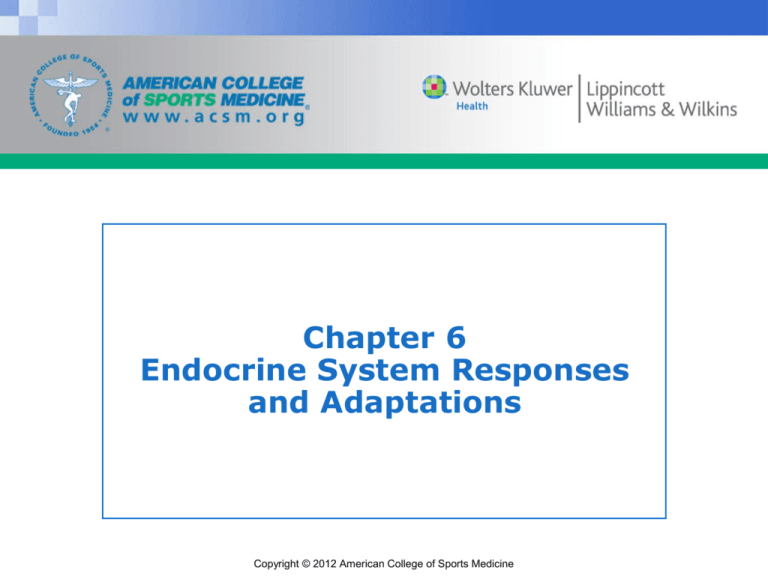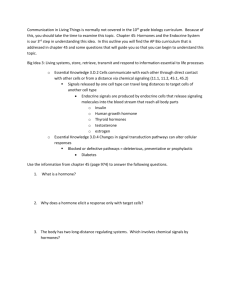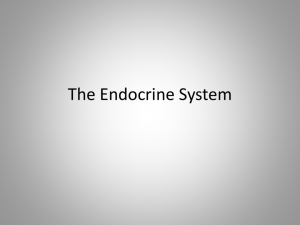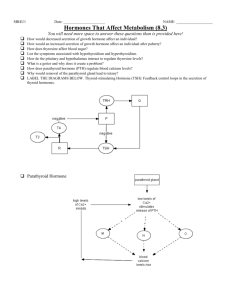LWW PPT Slide Template Master
advertisement

Chapter 6 Endocrine System Responses and Adaptations Copyright © 2012 American College of Sports Medicine Endocrine System: Overview • General Functions – Helps body maintain normal function – Prepares body for exercise – Mediates several adaptations – Is involved in every system • Mechanism – Releases chemical messenger (hormone) – Transports hormone to target tissue – Elicits chain of events leading to desired function Copyright © 2012 American College of Sports Medicine Hormone Actions • Autocrine Actions – Hormone acts on cells that produced it • Paracrine Actions – Hormone acts on cells adjacent to the ones that produced it • Endocrine Actions – Hormone enters general circulation & travels systematically to specific target tissues Copyright © 2012 American College of Sports Medicine Role of Releasing Hormone • Releasing Hormones – Hormones that cause the release of other hormones – Hypothalamus • Segment of brain that acts as an endocrine gland • Provides link between nervous & endocrine systems • Synthesizes & releases neurohormones to the pituitary gland Copyright © 2012 American College of Sports Medicine Role of Releasing Hormone (cont’d) • Hormones Released by the Hypothalamus – Corticotropin-releasing hormone (CRH) – Gonadotropin-releasing hormone (GnRH) – Growth hormone-releasing hormone – Growth hormone-inhibiting hormone – Thyrotropin-releasing hormone (TRH) – Prolactin-inhibiting hormone (PIH) Copyright © 2012 American College of Sports Medicine Role of Releasing Hormone (cont’d) • Hormones Released by the Pituitary in Response to the Release of Hormones from the Hypothalamus – Growth hormone (GH) – Follicle-stimulating hormone (FSH) – Luteinizing hormone (LH) – Adrenocorticotropic hormone (ACTH) – Thyroid-stimulating hormone (TSH) – Prolactin – Beta-endorphins Copyright © 2012 American College of Sports Medicine Types of Hormones • Steroid Hormones – Made of three 6-carbon rings & one 5-carbon ring – Synthesized from cholesterol via synthetic pathways – Actions: • Released into circulation • Arrive at target tissue • Diffuse through cell membrane • Bind to specific receptor within cell Copyright © 2012 American College of Sports Medicine Types of Hormones (cont’d) • Common Steroid Hormones – Androgens: testosterone (TE) – Glucocorticoids: cortisone – Progesterone – Prostaglandins – Anabolic steroids: commonly used/abused by athletes Copyright © 2012 American College of Sports Medicine Types of Hormones (cont’d) • Peptide Hormones – Proteins of various sizes • Peptides: small chains • Polypeptides: large chains – Direct product of: • mRNA translation • Cleavage from larger parent molecules • Other postsynthesis modifications – Circulate & bind to specific receptors on cell membranes of target tissues Copyright © 2012 American College of Sports Medicine Types of Hormones (cont’d) • Common Peptide Hormones – Insulin – Insulin-like growth factor-I (IGF-I) – Superfamily of GH molecules Copyright © 2012 American College of Sports Medicine Types of Hormones (cont’d) • Amine Hormones – Have amine (NH2) group at end of molecule – Derived from amino acids – Classified as protein hormones – Synthesized from: • Tyrosine • Phenylalanine • Tryptophan – Must bind to surface-bound receptor on target tissue – Can act as neurotransmitters in autonomic nervous system Copyright © 2012 American College of Sports Medicine Types of Hormones (cont’d) • Common Amine Hormones (catecholamines) – Epinephrine – Norepinephrine – Dopamine Copyright © 2012 American College of Sports Medicine Major Endocrine Glands in the Human Body Copyright © 2012 American College of Sports Medicine Hormone Activity: Production, Release, and Transportation • Production & Release – Peptides & amines are synthesized in advance & stored in vesicles until needed – Steroids are synthesized from cholesterol & released (not stored) • Transportation – Released into circulation & transported to target tissues – Half-life: time it takes for half of hormone to be degraded – Transport (binding) proteins • Protect hormone from metabolism • Deliver hormone to its receptor Copyright © 2012 American College of Sports Medicine Hormone Activity: Production, Release, and Transportation (cont’d) • What Determines Hormonal Concentrations in the Blood? – Amount of hormone released – Pattern of release (pulsatility) – Rate of metabolism – Quantity of transport proteins – Time of day (circadian patterns) – Plasma volume shifts (during exercise) Copyright © 2012 American College of Sports Medicine Hormone Activity: Production, Release, and Transportation (cont’d) • Negative Feedback Control – Elevates a hormone when it is low – Reduces a hormone when it is elevated – Example: athlete using anabolic steroids— • Reductions in testosterone production lead to • Testicular shrinkage due to • Negative feedback inhibition of endogenous TE production Copyright © 2012 American College of Sports Medicine Receptor Interaction • Receptor Specificity – Lock-and-key principle: only one hormone will unlock or activate each receptor – Cross-reactivity: allows more than one hormone or molecule to activate a receptor Copyright © 2012 American College of Sports Medicine Receptor Interaction (cont’d) • Steroid and Thyroid Hormones – Steroids, because they are lipophilic: • Diffuse through target cell membranes • Bind to receptors in cytoplasm or nucleus – Receptors are bound to heat-shock proteins in cytoplasm prior to hormone binding Copyright © 2012 American College of Sports Medicine Hormones and Exercise • Exercise Presents a Potent Stimulus for Hormonal Adaptations • Resistance Training (RT) Acute Program Variables – Intensity – Volume – Rest intervals – Exercise selection & sequence – Repetition velocity – Frequency Copyright © 2012 American College of Sports Medicine Hormones and Exercise (cont’d) • Aerobic, Plyometric, Sprint, & Agility Training Variables – Intensity – Volume & duration – Modality – Work:rest ratio – Frequency Copyright © 2012 American College of Sports Medicine Hormones and Exercise (cont’d) • Other Variables Affecting Hormonal Responses – Genetic predisposition – Gender – Fitness level – Nutritional intake – Potential for adaptation Copyright © 2012 American College of Sports Medicine Hormones and Exercise (cont’d) • Classifications of Hormonal Responses and Adaptations – Acute responses during exercise – Chronic changes in resting concentrations – Chronic changes in acute response to exercise – Receptor changes Copyright © 2012 American College of Sports Medicine Hormones and Exercise (cont’d) • Testosterone (testes) – Elevated during & immediately following exercise – Acute TE response weaker in women – Changes in resting TE during RT are inconsistent – Regulated by luteinizing hormone (LH) – Bound to sex hormone-binding globulin (SHBG) – Precursors: dehydroepiandrosterone (DHEA), androstendione, & androstenediol Copyright © 2012 American College of Sports Medicine Hormones and Exercise (cont’d) • Growth Hormone (GH) Superfamily (anterior pituitary-brain) – Secreted by anterior pituitary – Released in pulsatile manner – Under control of GHRH & inhibited by somatostatin – Exercise is a potent stimulus for GH secretion – No apparent change in resting GH with consistent exercise – 50% of GH binds to GH-specific binding proteins (GHBPs) that extend its half-life & enhance its effects Copyright © 2012 American College of Sports Medicine Hormones and Exercise (cont’d) • Insulin-Like Growth Factors (IGFs) (liver) – Structurally related to insulin & mediate many actions of GH – Small polypeptide hormones secreted by liver in response to GH stimulation – Increase proliferation & differentiation of satellite cells & protein synthesis – Enhance muscle hypertrophy – IGF-1 response to exercise is unclear – No consistent pattern of change in IGF-1 during exercise Copyright © 2012 American College of Sports Medicine Hormones and Exercise (cont’d) • Insulin (pancreas) – Secreted from Islets of Langerhans (B cells) in pancreas – Secreted in response to glucose intake – Increases muscle protein synthesis when amino acid is adequate – Aerobic & anaerobic training: • Improves insulin sensitivity • Reduces insulin resistance Copyright © 2012 American College of Sports Medicine Hormones and Exercise (cont’d) • Glucagon (pancreas) – Protein hormone consisting of 29 amino acids – Synthesized in A cells in Islets of Langerhans of pancreas – Inhibited by glucose levels – Stimulates breakdown of glycogen – Increases energy availability – Elevated during exercise as energy demands increase Copyright © 2012 American College of Sports Medicine Hormones and Exercise (cont’d) • Cortisol (adrenal cortex; perimeter of adrenal gland top of kidney) – Catabolic glucocorticoid released from adrenal cortex in response to stress under the control of CRH & ACTH – Stimulates lipolysis in adipose cells – Increases protein degradation in muscle cells – Decreases protein synthesis in muscle cells – Elevated during aerobic exercise, with greater response occurring with greater intensity – Increased during RT – Resting concentrations reflect a long-term stress & are transient Copyright © 2012 American College of Sports Medicine Hormones and Exercise (cont’d) • Catecholamines (adrenal medulla; adrenal gland-top kidney) – Secreted by adrenal medulla – Secreted in response to stress (physical, heat, hypoxia, hypoglycemia) – Increased during both aerobic & anaerobic exercise – Magnitude of increase depends on: • Muscle mass involved • Posture • Intensity • Duration Copyright © 2012 American College of Sports Medicine Hormones and Exercise (cont’d) • β-Endorphins (anterior pituitary-brain) – 31-amino acid peptide cleaved in anterior pituitary from parent – Act as neurotransmitters in nervous system & as analgesics – Increase relaxation – Enhance immune function – Increased with exercise, with response depending on intensity & duration Copyright © 2012 American College of Sports Medicine Hormones and Exercise (cont’d) • Thyroid Hormones (thyroid gland-neck) – Thyroxine (T4) & triiodothyronine (T3) released into circulation – Travel mostly bound to transport proteins – Increase basal metabolic rate – Increase protein synthesis – Augment actions of catecholamines – Response to exercise not clear Copyright © 2012 American College of Sports Medicine Hormones and Exercise (cont’d) • Fluid-Regulatory Hormones – Fluid homeostasis is critical to exercise performance – Elevations in AVP, atrial peptide, renin, aldosterone, & angiotensin II during exercise – Magnitude of increase dependent on intensity, duration, fitness level, & hydration status Copyright © 2012 American College of Sports Medicine Hormones and Exercise (cont’d) • Leptin (adipose tissue) – Product of ob gene in adipose tissue – Relays satiety signal to hypothalamus to regulate energy balance & appetite – Higher levels in obese individuals (4 times greater) & women – Crosses blood-brain barrier to act with receptors – Concentrations influenced by insulin, glucocorticoids, catecholamines, thyroid hormones, TE, GH, & stimulants – Not affected by exercise, independent of % body fat Copyright © 2012 American College of Sports Medicine Hormones and Exercise (cont’d) • Estrogens (Ovaries) – Include estradiol, estriol, & estrone – Have long half-lives – Synthesized & secreted primarily by ovaries in women, under control of LH & FSH – Produced from conversion of androgens in men – Response to exercise unclear Copyright © 2012 American College of Sports Medicine








